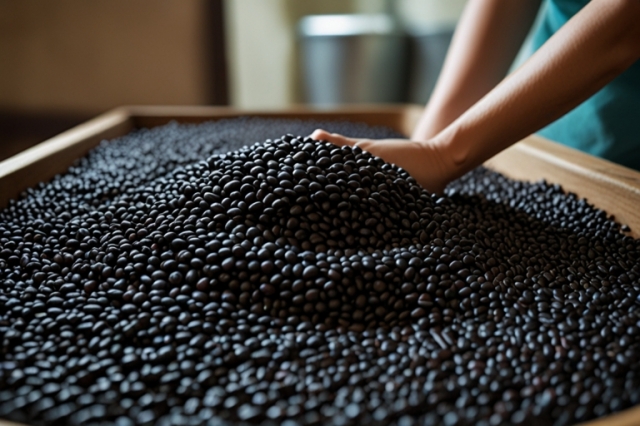IMARC Group's report, “Black Bean Processing Plant Project Report 2025: Industry Trends, Plant Setup, Machinery, Raw Materials, Investment Opportunities, Cost and Revenue,” offers a comprehensive guide for establishing a manufacturing plant. The black bean processing plant cost report offers insights into the manufacturing process, financials, capital investment, expenses, ROI, and more for informed business decisions.
Black Bean Processing Plant Project Report Summary: -
- Comprehensive guide for setting up a black bean processing plant.
- Covers market trends and industry outlook for 2025.
- Detailed project setup, including unit operations and processes.
- Raw material and utility requirements.
- Infrastructure and machinery specifications.
- Workforce and staffing requirements.
- Packaging and transportation details.
- Financial aspects: investment opportunities, cost analysis, and revenue projections.
In addition to covering operational aspects, the report offers detailed insights into the black bean processing plant process and project economics.
- Detailed insights into the black bean processing plant process.
- In-depth project economics and financial metrics.
- Covers capital investments and project funding.
- Analysis of operating expenses and income projections.
- Breakdown of fixed and variable costs, direct and indirect expenses.
- Evaluation of ROI (Return on Investment) and NPV (Net Present Value).
- Profit and Loss account analysis.
- Comprehensive financial analysis for decision-making.
- Provides a roadmap for successfully establishing a black bean processing
Request for a Sample Report: https://www.imarcgroup.com/black-bean-processing-plant-project-report/requestsample
What is Black Bean?
A black bean processing plant is a specialized facility designed to clean, sort, and prepare black beans for consumption or further industrial use in food products. The process begins with the intake of raw harvested black beans, which are cleaned to remove dust, stones, and other foreign materials using vibrating sieves, air classifiers, and magnetic separators. The beans are then sorted based on size and quality using optical sorters to ensure uniformity. Depending on the final product specification, the beans may be sold as whole dried beans or undergo additional processing such as soaking, cooking, and canning. Some plants also produce black bean flour, pastes, or ready-to-eat products like seasoned beans and soups. Key machinery in such facilities includes washing systems, blanchers, cookers, dryers, milling equipment, and automated packaging lines. Quality control laboratories test for moisture content, microbial safety, and nutritional standards, ensuring compliance with food safety certifications such as ISO 22000, HACCP, or FDA guidelines. Modern plants may also incorporate eco-friendly practices like water recycling and energy-efficient operations. A black bean processing plant plays a crucial role in extending the shelf life, usability, and market reach of this nutrient-rich legume, serving retail, foodservice, and export markets with high-quality, ready-to-use products.
Market Trends and Drivers:
The black bean processing market is driven by increasing global demand for plant-based protein sources, rising health consciousness, and the growing popularity of vegetarian and vegan diets. Black beans are rich in fiber, protein, antioxidants, and essential nutrients, making them a favored choice among health-conscious consumers and food manufacturers seeking functional ingredients. Their versatility in culinary applications—ranging from soups, stews, and salads to meat substitutes and snacks—boosts their appeal across a wide range of food segments. The surge in ready-to-eat and convenience food consumption is also propelling demand for pre-cooked, canned, and packaged black bean products. Additionally, food manufacturers are incorporating black bean flour and pastes into gluten-free and high-protein formulations, further expanding market opportunities. Increased awareness of sustainable agriculture and environmental concerns is prompting consumers to choose legumes over animal protein, aligning with global climate goals. Emerging markets in Asia, Africa, and Latin America are experiencing rising per capita consumption of legumes due to government nutrition programs and growing urbanization. Technological advancements in sorting, cleaning, and packaging have improved processing efficiency and product shelf life, facilitating wider distribution. With its nutritional profile and compatibility with health and sustainability trends, the black bean processing market is poised for steady global growth.
Key Insights Covered in the Black bean processing Plant Report
Market Coverage:
- Market Trends: Analysis of current and emerging trends in the black bean processing market.
- Market Segmentation: Breakdown of the market by different segments.
- Regional Analysis: Distribution and performance of the market across various regions.
- Price Analysis: Evaluation of pricing trends for black bean processing .
- Impact of COVID-19: Examination of the effects of the COVID-19 pandemic on the black bean market.
- Market Forecast: Outlook and projections for the black bean processing industry.
Key Aspects Required for Setting Up a Black bean Plant
Detailed Process Flow:
- Product Overview: Comprehensive description of the black bean processing product and its characteristics.
- Unit Operations Involved: Step-by-step breakdown of the various operations in the production process.
- Mass Balance and Raw Material Requirements: Calculations for material inputs and outputs, along with required quantities of raw materials.
- Quality Assurance Criteria: Standards and procedures to ensure the quality of the final product.
- Technical Tests: Essential tests and evaluations to maintain product consistency and compliance.
Project Details, Requirements, and Costs Involved
- Land, Location, and Site Development: Assessment of land requirements, optimal location selection, and site development costs.
- Plant Layout: Design and layout planning for efficient plant operations.
- Machinery Requirements and Costs: Identification of machinery needed, along with the associated costs.
- Raw Material Requirements and Costs: Determination of the types and quantities of raw materials required and their costs.
- Packaging Requirements and Costs: Specifications for packaging materials and equipment, including associated expenses.
- Transportation Requirements and Costs: Logistics planning and cost estimation for the transportation of raw materials and finished products.
- Utility Requirements and Costs: Analysis of utility needs (such as water, electricity, and fuel) and their associated costs.
- Human Resource Requirements and Costs: Workforce planning, including staffing needs, roles, and costs for labor and management.
Project Economics
- Capital Investments: Initial costs required for setting up the black bean processing plant, including land, equipment, and infrastructure.
- Operating Costs: Ongoing expenses for running the plant, such as raw materials, labor, utilities, and maintenance.
- Expenditure Projections: Detailed forecasts of all costs over the short and long term.
- Revenue Projections: Expected income generated from the sale of black bean processing and by-products.
- Taxation and Depreciation: Analysis of tax obligations, incentives, and asset depreciation over time.
- Profit Projections: Estimated profitability based on costs, revenues, and market conditions.
- Financial Analysis: Comprehensive evaluation of the plant's financial viability, including cash flow analysis, return on investment (ROI), and break-even point.
Ask Analyst for Customization: https://www.imarcgroup.com/request?type=report&id=10647&flag=C
Customization Options Available:
- Plant Location: Selection of optimal location for the plant.
- Plant Capacity: Customization based on desired production capacity.
- Machinery: Choice between automatic, semi-automatic, or manual machinery.
- List of Machinery Providers: Identification of suitable machinery suppliers.
Key Questions Addressed in This Report:
- How has the black bean processing market performed so far and how will it perform in the coming years?
- What is the market segmentation of the global black bean processing market?
- What is the regional breakup of the global black bean processing market?
- What are the price trends of various feedstocks in the black bean processing industry?
- What is the structure of the black bean processing industry and who are the key players?
- What are the various unit operations involved in a black bean processing plant?
- What is the total size of land required for setting up a black bean processing plant?
- What is the layout of a black bean processing plant?
- What are the machinery requirements for setting up a black bean processing plant?
- What are the raw material requirements for setting up a black bean processing plant?
How IMARC Can Help?
IMARC Group is a global management consulting firm that helps the world's most ambitious changemakers to create a lasting impact. The company provide a comprehensive suite of market entry and expansion services. IMARC offerings include thorough market assessment, feasibility studies, company incorporation assistance, factory setup support, regulatory approvals and licensing navigation, branding, marketing and sales strategies, competitive landscape and benchmarking analyses, pricing and cost research, and procurement research.
Services:
- Plant Setup
- Factoring Auditing
- Regulatory Approvals, and Licensing
- Company Incorporation
- Incubation Services
- Recruitment Services
- Marketing and Sales
Contact Us:
IMARC Group
134 N 4th St. Brooklyn, NY 11249, USA
Email: sales@imarcgroup.com
Tel No:(D) +91 120 433 0800
United States: +1-631-791-1145






